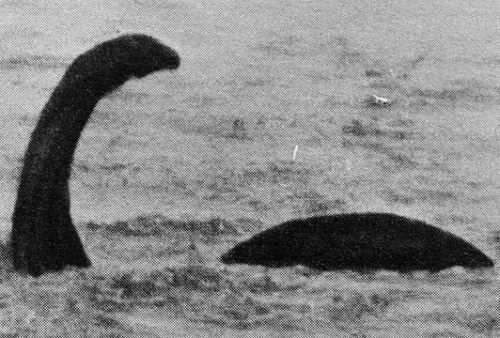In 1981, Under Scotland’s Wildlife And Countryside Act, The Scottish Government Made It Illegal For

In 1981, under Scotland’s Wildlife and Countryside Act, the Scottish government made it illegal for anyone to attempt to capture, snare, or shoot at the Loch Ness Monster.
More Posts from Jackasslope and Others

Said to reside in Normandy, particularly the commune of Bayeux, is the legend of the Rongeur d’Os. This large black dog’s name can be translated to “Bone Gnawer” or “Gnawer of Bones”. The Rongeur d’Os is said to drag a long chain behind it and always have a bone in its mouth. Like many black dog legends, the Rongeur d’Os is said to be an omen of death and strikes fear into travelers that it comes across.

The Tasmanian Tiger - Thylacinus cynocephalus
The Mammals of Australia. Krefft, from photographs by Victor A. Prout, 1869.

The Official Loch Ness Monster Sighting Register keeps a page on its website that highlights what does not make a Nessie sighting. The website uses actual accounts that have been reported to it to help decipher what shouldn’t be reported as a legitimate sighting. Some are the more common things that photographs or videos have been debunked as, such as boat wakes, seals, and floating logs. But some others include birds, divers, and even insects. The Register does explain itself on these. It says that the splashes from birds diving or taking off from the water can sometimes look like something suspicious. It explains a situation in 2015 where a woman reported a Nessie sighting but it was debunked as divers that were getting footage for Google Maps’ street view. As for the insects, the Register talks about how bugs too close to the camera lens can sometimes appear monster-ish.


Hidebehind
A strong, nocturnal creature which feeds off the intestines of its prey. It captures and hides from wayfarers in the woods by sucking in its body so that it can hide behind the trunk of any tree, or the person trying to look at it. It is said they have an aversion to alcohol.
Jorge Luis Borges - Book of Imaginary Beings
-
 radprincellama liked this · 8 months ago
radprincellama liked this · 8 months ago -
 kyle-mason liked this · 8 months ago
kyle-mason liked this · 8 months ago -
 eewwwdude2 liked this · 8 months ago
eewwwdude2 liked this · 8 months ago -
 lostinday reblogged this · 8 months ago
lostinday reblogged this · 8 months ago -
 luna-nigthshade-wood reblogged this · 8 months ago
luna-nigthshade-wood reblogged this · 8 months ago -
 luna-nigthshade-wood liked this · 8 months ago
luna-nigthshade-wood liked this · 8 months ago -
 dontfindwaldo liked this · 8 months ago
dontfindwaldo liked this · 8 months ago -
 eventhedarkestlightshines reblogged this · 8 months ago
eventhedarkestlightshines reblogged this · 8 months ago -
 eventhedarkestlightshines liked this · 8 months ago
eventhedarkestlightshines liked this · 8 months ago -
 emu-lumberjack liked this · 8 months ago
emu-lumberjack liked this · 8 months ago -
 hinari liked this · 8 months ago
hinari liked this · 8 months ago -
 icouldbeaduck liked this · 8 months ago
icouldbeaduck liked this · 8 months ago -
 nerd-nowandforever liked this · 8 months ago
nerd-nowandforever liked this · 8 months ago -
 virgil-is-a-cutie reblogged this · 8 months ago
virgil-is-a-cutie reblogged this · 8 months ago -
 virgil-is-a-cutie liked this · 8 months ago
virgil-is-a-cutie liked this · 8 months ago -
 seraphichana reblogged this · 8 months ago
seraphichana reblogged this · 8 months ago -
 seraphichana liked this · 8 months ago
seraphichana liked this · 8 months ago -
 sunsetkiss liked this · 1 year ago
sunsetkiss liked this · 1 year ago -
 creativeuserrsstuff liked this · 2 years ago
creativeuserrsstuff liked this · 2 years ago -
 dosisdeadrenalina reblogged this · 2 years ago
dosisdeadrenalina reblogged this · 2 years ago -
 chantal-world-foreveryoung liked this · 2 years ago
chantal-world-foreveryoung liked this · 2 years ago -
 gypskyy reblogged this · 2 years ago
gypskyy reblogged this · 2 years ago -
 xbbydollx reblogged this · 2 years ago
xbbydollx reblogged this · 2 years ago -
 raven-said-nevermore reblogged this · 2 years ago
raven-said-nevermore reblogged this · 2 years ago -
 rollingthvnder reblogged this · 2 years ago
rollingthvnder reblogged this · 2 years ago -
 dannyboyrope reblogged this · 2 years ago
dannyboyrope reblogged this · 2 years ago -
 dannyboyrope liked this · 2 years ago
dannyboyrope liked this · 2 years ago -
 bts04208 liked this · 2 years ago
bts04208 liked this · 2 years ago -
 nev3r--com1ng--d0wn reblogged this · 2 years ago
nev3r--com1ng--d0wn reblogged this · 2 years ago -
 randomxfangirlxblogger liked this · 2 years ago
randomxfangirlxblogger liked this · 2 years ago -
 vixiegore reblogged this · 2 years ago
vixiegore reblogged this · 2 years ago -
 vixiegore liked this · 2 years ago
vixiegore liked this · 2 years ago -
 moonlab liked this · 3 years ago
moonlab liked this · 3 years ago -
 lastoftherunaways reblogged this · 3 years ago
lastoftherunaways reblogged this · 3 years ago -
 lastoftherunaways liked this · 3 years ago
lastoftherunaways liked this · 3 years ago






